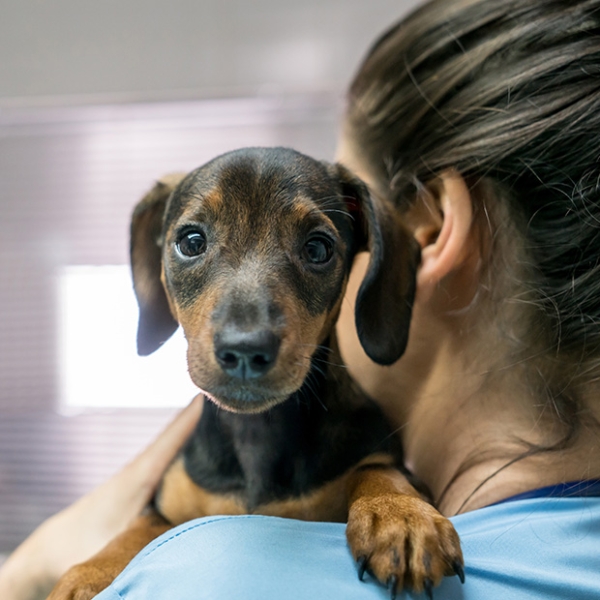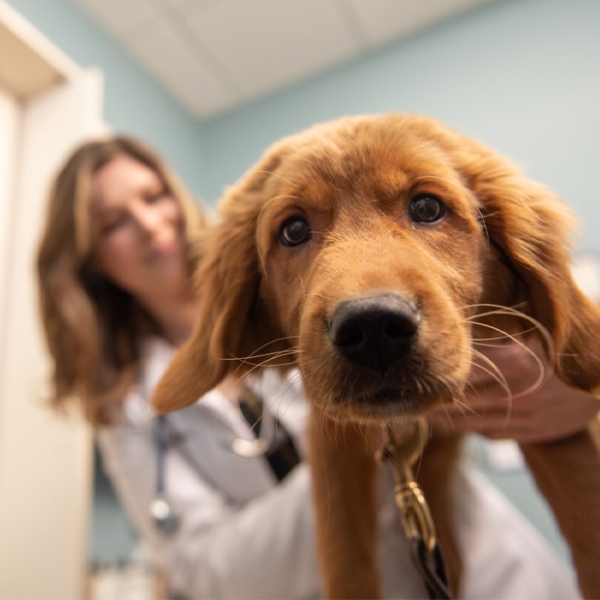Canine parvovirus
Canine parvovirus infection is a highly contagious disease caused by canine parvovirus type 2 (CPV-2). There are several strains of CPV-2, and all produce similar signs. The disease they cause is commonly called “parvo.”
The virus attacks white blood cells and the gastrointestinal tract of dogs and other canids like coyotes, wolves, and foxes. In puppies, the virus also can damage the heart muscle.
All dogs are susceptible to canine parvovirus, although some dogs are at greater risk than others. These include puppies between 6 and 20 weeks of age, unvaccinated or incompletely vaccinated dogs, and certain breeds, such as the following:
- Rottweilers
- Doberman pinschers
- Bull terrier breeds
- German shepherds
- English springer spaniels
What are the signs of canine parvovirus?
The signs of parvovirus infection vary from dog to dog, depending on the severity of the infection. These are some important signs to watch out for:
- Lethargy
- Loss of appetite
- Vomiting
- Severe, often bloody, diarrhea
- Abdominal pain and bloating
- Fever or low body temperature (hypothermia)
If your dog shows any of these signs, immediately contact your veterinarian. Persistent vomiting and diarrhea can quickly cause dehydration, and damage to the intestines and immune system can cause septic shock. This can lead to death, with most deaths occurring within 48 to 72 hours after signs first appear.
How is canine parvovirus spread?
Canine parvovirus is easily spread by direct contact with infected dogs, contact with feces (stool) from infected dogs, or contact with virus-contaminated surfaces. Such surfaces can include kennels, food and water bowls, collars and leashes, and the hands and clothing of people who handle infected dogs. Contact between domestic dogs, feral dogs, and wild canids also may play a role in spreading the disease.
The virus is resistant to heat, cold, humidity, and drying, and can survive in the environment for long periods. Even trace amounts of feces from an infected dog can contain the virus and infect other dogs. This makes proper disinfection practices critical.
Because canine parvovirus is highly contagious, dogs suspected or confirmed to be infected need to be isolated from other dogs to minimize spread of infection. Other strict infection control protocols also must be followed, including thorough cleaning and disinfection of any areas where the dog has been with products capable of killing the virus. If your dog has parvovirus infection, your veterinarian can recommend things you can do to help prevent parvovirus from spreading at home and elsewhere.
How is canine parvovirus diagnosed and treated?
Your veterinarian may suspect parvovirus infection based on the signs your dog is showing, your dog’s history, and other factors. Fecal testing can confirm the diagnosis.
Dogs with severe infection need immediate, intensive treatment and 24/7 monitoring—which often involves several days of hospitalization. Supportive care is provided to correct dehydration and physiological imbalances caused by vomiting and diarrhea, control nausea and pain, keep the dog warm, prevent other infections from happening, and provide nutritional support. Additional treatment may be recommended to help fight the infection and/or combat diarrhea. This can all be very expensive, and the dog may die despite treatment. Prompt, intensive treatment improves the chance of survival.
How can I protect my dog against canine parvovirus?
Vaccination and other preventive measures—including good hygiene—are key to avoiding canine parvovirus infection.
Young puppies are especially vulnerable to canine parvovirus. If a mother dog has antibodies against parvovirus, as can occur when she’s been vaccinated, then she may pass those antibodies to her newborn puppies through her milk. However, this natural immunity may wear off before the puppies' own immune systems are mature enough to fight off infection. And, if a puppy is exposed to the virus during this gap in protection, the dog may become ill. An additional concern is that immunity provided by a mother's milk may interfere with an effective response to vaccination. This means that occasionally even vaccinated puppies may become infected and become ill.
To reduce gaps in immunity and provide the best protection against canine parvovirus during the first few months of life, a series of vaccinations is recommended. The parvovirus vaccine is included in a combination vaccine (sometimes abbreviated DAPP, DA2PP, or similarly) that also protects dogs against some other common canine viruses. This vaccine is considered “core,” and is recommended for all dogs. Puppies younger than 16 weeks should receive their first dose at between 6 and 8 weeks of age, then two more doses 2-4 weeks apart. Dogs older than 16 weeks with no previous vaccination or an unknown history should receive two doses 2-4 weeks apart.
To maintain protection, a booster dose of the combination vaccine is recommended within one year after the last dose in the initial vaccination series. Afterward, boosters are recommended every three years.
If your adult dog hasn’t been vaccinated yet, or is overdue or missing some vaccinations, it’s not too late. Ask your veterinarian about a recommended vaccination program based on your dog’s age and needs.
These additional measures also can help protect your dog and other animals from canine parvovirus and other infectious agents:
- Until the initial vaccination series is complete, use caution when bringing puppies to places where dogs gather. This includes pet shops, parks, puppy and obedience classes, doggy day cares, kennels, and groomers.
- Choose establishments and training programs that require up-to-date vaccinations, health examinations, good hygiene, and isolation of sick puppies and dogs.
- Keep your dog away from other dogs when sick, including other dogs within your home.
- Avoid contact with known infected dogs and their premises.
- Keep your dog away from other dogs’ feces.
- Routinely collect and properly dispose of your dog’s feces.
- If you’ve been in contact with dogs with or exposed to parvovirus, avoid handling other dogs, or wash your hands and change your clothes before doing so.
Get the brochure
Keep canine parvovirus information on hand, whether at home or in the clinic.
Also in Spanish: Parvovirus canino



